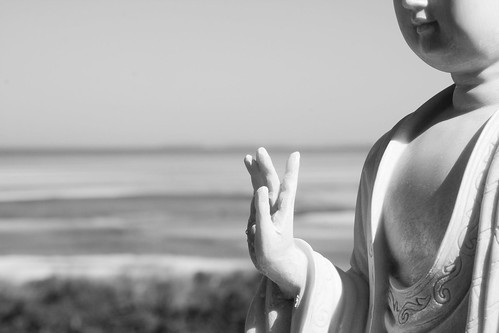You have found a place, arranged something to sit on, be it zafu or blanket or folding chair from the old card table set. You have "assumed the position," as it were. You're breathing.
So exactly what is it we're supposed to be doing here?
Many teachers in the Soto Zen tradition would say, That's it. Just continue sitting. As unsatisfactory as this answer may be to the new meditator, it is to a degree accurate. The Japanese word for this type of meditation is shikantaza, literally "just sitting." It's an incredibly profound and powerful practice. But because you're still a newbie, you don't see it yet. And that's OK.
The goal (if I may use that word) of all Buddhist practice--sitting, walking, chanting, bowing--is to become grounded in the present moment. In Zen, we always say the most important thing is, "What are you doing right now? What is the truth of this moment?" So we want to apply that principle to our sitting practice.
In a book called Zen Judaism (by David M. Bader), I found the following: "Breathe in. Breathe out. Breathe in. Breathe out. Forget this and attaining Enlightenment will be the least of your problems." But of course, we never "forget" to breathe, do we? It happens by itself, the same way we beat our heart or grow our hair. Awareness of the breath becomes a very handy way to make the unconscious conscious.
Typically, focusing on the breath goes like this: breathe in, breathe out--count "one." Breathe in, breathe out--count "two." Continue in this way up to "ten." Then go back to "one" again. Don't force the breath or try to make it longer or shorter--just let it be whatever your body wants it to be.
While you're doing this, just place your attention on the bare sensation of breathing. Where do you feel it? Back of the throat? Inside the nose? Do you feel your chest rising and falling? Your abdomen expanding? Don't try to make those things happen; just notice them if they do happen.
With me so far? Easy, right? Now here's where the practice really heats up.
At some point, you're going to lose focus on the breath. You'll start to think about something else, and you'll suddenly realize you forgot what number you're on. That's no problem. In fact, that's what's supposed to happen! Because the real practice is to realize you've lost the present moment (in the form of concentrating on the breath), and gently bring your attention back to it. You do this by simply returning to counting, beginning with "one" again.
You'll be tempted to think you have "messed up," done something wrong. Some days you'll tell yourself you suck at meditation. That's incorrect. The practice is not to see how many times you can get up to ten breaths, but actually to lose your concentration and get it back again. Losing count is supposed to happen. You're doing fine.
Last thing: this breath-counting is an elementary practice. For many people, it's the first one they ever learn. That's just because it's easy to teach and easy for the student to do right away. But don't imagine that because it's a "beginner" technique it's something you'll outgrow as practice matures. This simple practice has such power, you could do it exclusively for many years and not exhaust its usefulness. You might get tired of it, but you'll come back to it over and over again. It's that good.
In Part Three, I'll tell you about a couple of things you can do when--despite what I just said above--you get tired of counting breaths.
Hapchang,
Mark

